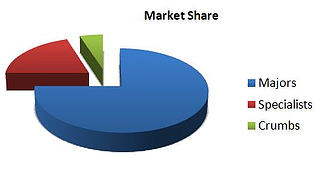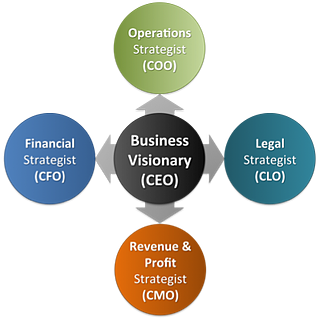Growth Insights for CEOs

Outsider Insights | From Hustle to System: Why More CEOs Are Rebuilding Their Sales Function
Outsider Insights
Across Chief Outsiders, we talk to hundreds of CEOs every month. In this new series, we explore the trends and challenges we’re hearing from these discussions – and what you can do if you’re facing the same issues in your business.
Recent Posts

The Accidental CEO and 5 Steps to Avoid Being the Reluctant CEO
Sun, Oct 28, 2012 — The Age Old Story You were content in life, working to contribute in operations, sales or product/technology development. You were a master, an expert in your field and were comfortable in your skin. Then the business was rocked when the leading family member became seriously ill; or your key partner suddenly seemed to go nuts — focusing on personal enrichment at the expense of the business; or simply sudden CEO succession was needed. It is an age-old story, a company needs a competent new leader — and through no fault or desire of your own, you find yourself playing the central role of the accidental or reluctant CEO. Over the years, I have met countless CEOs who never aspired to the position of business leader. Some took on the three letter title at startup but never really expected to be the leader of a significant, complex and demanding business. Others were suddenly thrust into the role to save the company or replace a previous CEO. Regardless of how it transpired, these CEOs did not aspire, position or groom themselves to lead a business, but they did step up when required.

The New CEO Mandate
Mon, Sep 17, 2012 — Guest post by Luis Gallardo, Author of Brands & Rousers: The Holistic System to foster High-Performing Businesses, Brands & Careers.

#1 Way to Innovate: Execute
Thu, Jul 5, 2012 — As business leaders, we’re seduced into believing that innovation is the key to competitive advantage. How could anyone argue that an industry-changing product wouldn’t be a company’s ticket to leadership and success? Well, Jim Collins and Morten Hansen make a compelling and empirically-grounded counter argument in “Great By Choice”. Their 10X companies (those with substantially greater long term performance) are actually less innovative than their more innovative but less successful counterparts. Ultimately, it’s the company that “innovates” incrementally that is better prepared (and productively paranoid) that wins the day. The Cambridge Group has written fairly extensively on innovation. In their book “How Companies Win” Kash and Calhoun start with a compelling definition: “Innovation is finding unsatisfied profitable demand, then fulfilling it.” They go on to describe dimensions of Total Innovation: Invention New Product Innovation Product Enhancement Innovation Commercial (non-product) Innovation Operational Innovation Business Model Innovation
Stay up-to-date with the latest from Chief Outsiders

Growth Opportunity: The Demand Chain
Mon, Mar 19, 2012 — Efficiency Only Goes So Far The last ten years of American business have been focused on integrating and perfecting operational efficiencies through the perfection and active management of the Supply Chain. For the last couple of years of economic turmoil, many companies have almost exclusively focused on supply chain efficiencies as a strategy for survival. Now the challenge is taking the expertise and company culture focused on linear thinking and introspection of the supply chain and start growing again.

Maximizing Your Position In Your Market
Mon, Sep 26, 2011 — Every company must develop a strategic direction that best fits its capabilities and its standing in its marketplace. Most business categories fall into similar market share patterns. There are three major players who, combined, have roughly 70-90% of the market. Then you have a group of small savvy specialists that have identified an underserved audience within the market. These tend to be businesses that succeed based on lower volumes, by definition, but much higher margins. In general, they tend to have no more than 5% of the market each. And, finally, you have the remaining companies in the category that live on the crumbs that are left over.

3 Top Sources of Strategic Marketing Insights
Mon, Jul 18, 2011 — Effective marketing strategies that drive significant results are almost always based on key insights. Insights can come from a lot of different places – from research, from a review of operations, from an analysis of the market, from a review of available data, from experience. The critical common element to game-changing insights is perspective – looking at the situation from a customer/prospect/market point of view. Let’s look at some examples: 1. Research-based Insight At Northeast Savings, we conducted a major customer segmentation study to better understand the needs of our consumers. One of the key findings of the research was a hierarchy of concerns expressed by a key constituency – 50+ consumers. Their number one issue was their health; followed closely by their financial well being, especially as it related to being able to take care of themselves should anything happen to them physically. This insight, coupled with an understanding of the need for conservative investments (in this case, CDs) due to the risk profile of older people, led to the creation of the “Take Ten” CD. This was a traditional CD, earning market interest rates, with a twist – you could withdraw up to 10% of your principal without penalty. Northeast Savings was the first bank in the country to offer this type of CD and was recognized in USA Today. More importantly, the CD garnered $180M in new deposits in the first three months and, after a year, no one had exercised the option to withdraw principal. Consumers wanted the security of knowing that they could, but really needed to earn interest on their deposits.

Four Must-Have Strategists Every CEO Needs
Sun, May 8, 2011 — Every CEO has the responsibility to set the vision and make certain the strategies to address this vision are created and implemented. The CEO must determine what resource options are best suited to help develop and implement the various strategies and budget accordingly.

Building Company Value After an Acquisition
Sun, Mar 27, 2011 — Marketing’s Role in Post-Merger Integration The deal was just signed! Now what do we do? How many times have we heard this familiar cry? You are not alone. Over 70% of the deals completed today fail to add company value! The primary reason for most failures: poor post-merger integration planning and execution. The integration of two businesses after an acquisition is no longer restricted to the domain of Finance and IT. Markets drive our businesses today! The role of Marketing in building company value after an acquisition is more critical than ever before. To build market share, competitive dominance and product superiority, Marketing’s approach to the integration program must be very systematic. Marketing must uphold the brand, maintain customer confidence and leverage all possible synergies while vigilantly monitoring ROI. As if this isn’t a difficult enough balancing act, Marketing must articulate the longer-term “go-to-market” strategy to ensure the continuity of value enhancement programs long after the integration process is complete. So where do you begin?
.png?width=1500&height=398&name=CO_Corporate%20Logo%202021_4C_HOR_FNL-1%20(1).png)